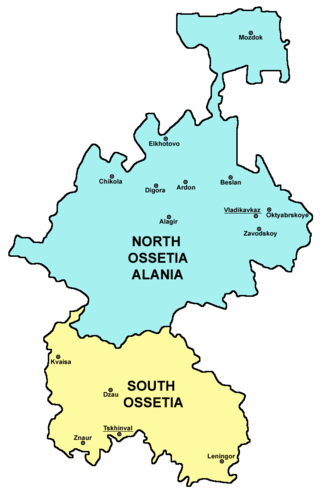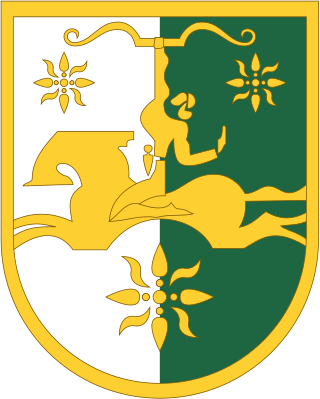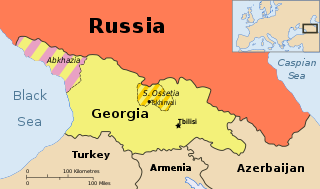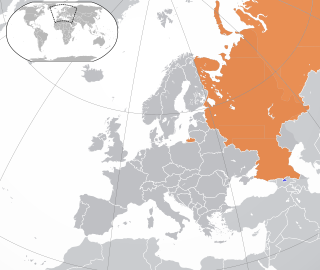
Ossetia is an ethnolinguistic region located on both sides of the Greater Caucasus Mountains, largely inhabited by the Ossetians. The Ossetian language is part of the Eastern Iranian branch of the family of Indo-European languages. Most countries recognize the Ossetian-speaking area south of the main Caucasus ridge as lying within the borders of Georgia, but it has come under the control of the de facto government of the Russian-backed Republic of South Ossetia – the State of Alania. The northern portion of the region consists of the Republic of North Ossetia-Alania within the Russian Federation.

South Ossetia, officially the Republic of South Ossetia or the State of Alania, is a partially recognised landlocked state in the South Caucasus. It has an officially stated population of just over 56,500 people (2022), who live in an area of 3,900 square kilometres (1,500 sq mi), with 33,000 living in the capital city, Tskhinvali.

The Georgian–Ossetian conflict is an ethno-political conflict over Georgia's former autonomous region of South Ossetia, which evolved in 1989 and developed into a war. Despite a declared ceasefire and numerous peace efforts, the conflict remained unresolved. In August 2008, military tensions and clashes between Georgia and South Ossetian separatists erupted into the Russo-Georgian War. Since then, South Ossetia has been under Russian occupation.

The Ossetian Military Road was constructed between 1854 and 1889, by the Russian Empire in the Caucasus. The road runs through the Rioni and Ardon river valleys and links Kutaisi (Georgia) with Alagir (Russia), crossing the Greater Caucasus crest through the Mamison Pass at 2,911 metres (9,551 ft). The 270 kilometres (170 mi) long route is seldom used today, having been supplanted by the 1971-1981 construction of the Transcaucasian Highway, which crosses the Caucasus range via the Roki Tunnel. Alternative crossings include the Georgian Military Road, which crosses the Jvari Pass at 2,379 metres (7,805 ft).

The Roki Tunnel is a mountain tunnel of the Transkam road through the Greater Caucasus Mountains, north of the village Upper Roka. It is the only road joining North Ossetia–Alania in Russia into South Ossetia, a breakaway republic of Georgia. The road is manned at the town of Nizhny Zaramag in North Ossetia and is sometimes referred to as the Roki-Nizhny Zaramag border crossing.
The Georgian–Ossetian conflict of 1918–1920 were a series of uprisings, which took place in the Ossetian-inhabited areas of what is now South Ossetia, a breakaway republic in Georgia, against the Transcaucasian Democratic Federative Republic and then the Menshevik-dominated Democratic Republic of Georgia which claimed several thousand lives and left painful memories among the Georgian and Ossetian communities of the region.

The Republic of Abkhazia is a partially recognized state in the South Caucasus which declared independence from Georgia during the War in Abkhazia (1992–1993). At the time, the Soviet Union had recently collapsed (1991).
The Transcaucasian Highway or TransKAM (ТрансКАМ) is a mountain highway in the South Caucasus region, connecting southern Russia and Georgia.

The 2008 Russo-Georgian War was a war between Russia, alongside the Russian-backed self-proclaimed republics of South Ossetia and Abkhazia, and Georgia. The war took place in August following a diplomatic crisis between Russia and Georgia, both formerly constituent republics of the Soviet Union. The fighting took place in the strategically important South Caucasus region. It is regarded as the first European war of the 21st century.

The Battle of Tskhinvali was a battle for the city of Tskhinvali, capital of the breakaway state of South Ossetia. It was the only major battle in the Russo-Georgian War. Georgian ground troops entered the city on early 8 August 2008, after an artillery assault. Georgians took control of most of the city in hours. Russian main forces began entering South Ossetia through the Roki tunnel. After being initially forced to withdraw, the Georgian troops made several attempts to retake the city. Due to the difficult logistics of the terrain, the arrival of Russian reinforcements was slow. After fierce fighting, Georgian troops were finally forced to withdraw from the city on the evening of 10 August. On 11 August, all Georgian troops left South Ossetia. Parts of Tskhinvali were devastated in the three-day fighting.

Abkhazia and South Ossetia are disputed territories in the Caucasus. Most countries recognise them as part of Georgia, while Russia, Venezuela, Nicaragua, Nauru, and Syria regard them as independent. Russia's initial recognition of the independence of Abkhazia and South Ossetia occurred in the aftermath of the Russo-Georgian War in 2008. The government of Georgia considers the republics to be Russian-occupied territories.

Russia–South Ossetia relations refers to the bilateral relationship between Russia and the Republic of South Ossetia, a disputed region in the South Caucasus, located on the territory of the South Ossetian Autonomous Oblast within the former Georgian Soviet Socialist Republic.

Dzau District is a district in South Ossetia.

Both sides of the 2008 war between Russia and Georgia blamed each other for starting the war.

The Georgia–Russia border is the state border between Georgia and Russia. It is de jure 894 km in length and runs from the Black Sea coast in the west and then along the Greater Caucasus Mountains to the tripoint with Azerbaijan in the east, thus closely following the conventional boundary between Europe and Asia. In 2008 Russia recognised the independence of two self-declared republics within Georgia, meaning that in a de facto sense the border is now split into four sections: the Abkhazia–Russia border in the west, the western Georgia–Russia border between Abkhazia and South Ossetia, the South Ossetia–Russia border and the eastern Georgia–Russia border between South Ossetia and Azerbaijan. At present most of the international community refuse to recognise the independence of the two territories and regard them as belonging to Georgia.

Java Municipality is a municipality of Georgia, in the region of Shida Kartli.

The Georgian S3 route, also known as Mtskheta-Stepantsminda-Larsi or Georgian Military Road, is a "road of international importance" within the Georgian road network and runs from Mtskheta to the border with Russia near Stepantsminda with a length of 139 kilometres (86 mi). After crossing the Georgian-Russian border the highway continues as A161 to Vladikavkaz, the capital of Russia's North Ossetia–Alania federal republic. The highway is the only open land route between Russia and Georgia (country), while routes via Georgian breakaways South Ossetia and Abkhazia are effectively closed for through traffic.

The Georgian S10 route, also known as "Gori-Tskhinvali-Gupta-Java-Roki ", is a "road of international importance" within the Georgian road network from Gori via Tskhinvali to the Russian border at the Roki Tunnel with a length of 92.5 kilometres (57.5 mi). After crossing the Russian border the road continues as A164 highway to Alagir and the R217 "Caucasus Highway". The S10 route, which intersects with the S1 highway just outside of the city of Gori, is often referred to as Transkam or Transcaucasian Highway. It is not part of European or Asian international highway routes.

South Ossetia is a partially recognized and Russian-occupied separatist state internationally recognized as part of Georgia. It is mainly inhabited by Ossetians, an ethnic group also dominant in North Ossetia, which is part of Russia. South Ossetia separated itself from Georgia following the 1991–1992 South Ossetia War with the help of Russia, remaining ever since as a state closely allied with this country.
Oleg Teziev is a military commander and soldier from the partially recognized Caucasian Republic of South Ossetia serving as the Republic's first Prime Minister.













